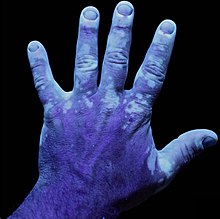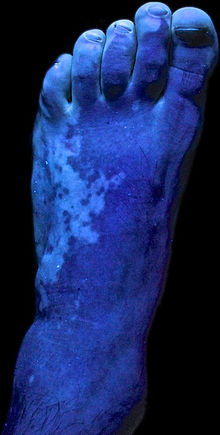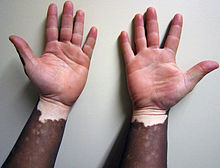Vitiligo
| Vitiligo | |
|---|---|
| Frequency | 1% of people[4] |
Vitiligo (
Signs and symptoms
The only sign of vitiligo is the presence of pale patchy areas of depigmented skin which tend to occur on the extremities.
-
Vitiligo on lighter skin
-
Non-segmental vitiligo on dark skin
-
Non-segmental vitiligo of the eyelids
Causes
Although multiple hypotheses have been suggested as potential triggers that cause vitiligo, studies strongly imply that changes in the immune system are responsible for the condition.[2][13] Vitiligo has been proposed to be a multifactorial disease with genetic susceptibility and environmental factors both thought to play a role.[2] It is hypothesized that damaging environmental factors can disrupt redox reactions necessary for protein folding, so skin cells may initiate the unfolded protein response which releases cytokines, thus mounting an immune response [14][15]
The National Institutes of Health states that some believe that sunburns can cause or exacerbate the condition, but this idea is not well-supported by good evidence.[16]
Immune
Melanin is the pigment that gives skin its color; it is produced by skin cells called melanocytes.
Variations in genes that are part of the immune system or part of melanocytes have both been associated with vitiligo.[2] It is also thought to be caused by the immune system attacking and destroying the melanocytes of the skin.[17] A genome wide association study found approximately 36 independent susceptibility loci for generalized vitiligo.[18]
The TYR gene encodes the protein
Autoimmune associations
Vitiligo is sometimes associated with
Among the inflammatory products of
Diagnosis


An
Classification
Classification attempts to quantify vitiligo have been analyzed as being somewhat inconsistent,[25] while recent consensus have agreed to a system of segmental vitiligo (SV) and non-segmental vitiligo (NSV). NSV is the most common type of vitiligo.[2]
Non-segmental
In non-segmental vitiligo (NSV), there is usually some form of symmetry in the location of the patches of depigmentation. New patches also appear over time and can be generalized over large portions of the body or localized to a particular area. Extreme cases of vitiligo, to the extent that little pigmented skin remains, are referred to as vitiligo universalis. NSV can come about at any age (unlike segmental vitiligo, which is far more prevalent in teenage years).[11]
Classes of non-segmental vitiligo include the following:
- Generalized vitiligo: the most common pattern, wide and randomly distributed areas of depigmentation[26]
- Universal vitiligo: depigmentation encompasses most of the body[26]
- Focal vitiligo: one or a few scattered macules in one area, most common in children[26]
- Acrofacial vitiligo: fingers and periorificial areas[26]
- Mucosal vitiligo: depigmentation of only the mucous membranes[26]
Segmental
Segmental vitiligo (SV) differs in appearance, cause, and frequency of associated illnesses. Its treatment is different from that of NSV. It tends to affect areas of skin that are associated with
Differential diagnosis
Chemical leukoderma is a similar condition due to multiple exposures to chemicals.[1] Vitiligo however is a risk factor.[1] Triggers may include inflammatory skin conditions, burns, intralesional steroid injections and abrasions.[1]
Other conditions with similar symptoms include the following:
- albinism
- halo nevus
- idiopathic guttate hypomelanosis (white sunspots)[26]
- piebaldism[26]
- pityriasis alba
- postinflammatory hypopigmentation
- primary adrenal insufficiency
- progressive macular hypomelanosis[26]
- tinea versicolor[26]
- tuberculoid leprosy.
Treatment
There is no cure for vitiligo but several treatment options are available.
Immune mediators
Topical preparations of immune suppressing medications including
In July 2022, ruxolitinib cream (sold under the brand name Opzelura) was approved for medical use in the United States for the treatment of vitiligo.[30]
Phototherapy
Phototherapy is considered a second-line treatment for vitiligo.[2] Exposing the skin to light from UVB lamps is the most common treatment for vitiligo. The treatments can be done at home with an UVB lamp or in a clinic. The exposure time is managed so that the skin does not suffer overexposure. Treatment can take a few weeks if the spots are on the neck and face and if they existed not more than 3 years. If the spots are on the hands and legs and have been there for more than 3 years, it can take a few months. Phototherapy sessions are done 2–3 times a week. Spots on a large area of the body may require full body treatment in a clinic or hospital. UVB broadband and narrowband lamps can be used,[31][32] but narrowband ultraviolet peaked around 311 nm is the choice. It has been constitutively reported that a combination of UVB phototherapy with other topical treatments improves re-pigmentation. However, some people with vitiligo may not see any changes to skin or re-pigmentation occurring. A serious potential side effect involves the risk of developing skin cancer, the same risk as an overexposure to natural sunlight.[citation needed]
Ultraviolet light (
Narrowband ultraviolet B (NBUVB) phototherapy lacks the side-effects caused by psoralens and is as effective as PUVA.[2] As with PUVA, treatment is carried out twice weekly in a clinic or every day at home, and there is no need to use psoralen.[29] Longer treatment is often recommended, and at least 6 months may be required for effects to phototherapy.[33] NBUVB phototherapy appears better than PUVA therapy with the most effective response on the face and neck.[33]
With respect to improved repigmentation: topical calcineurin inhibitors plus phototherapy are better than phototherapy alone,[34] hydrocortisone plus laser light is better than laser light alone, ginkgo biloba is better than placebo, and oral mini-pulse of prednisolone (OMP) plus NB-UVB is better than OMP alone.[9]
Skin camouflage
In mild cases, vitiligo patches can be hidden with makeup or other cosmetic camouflage solutions. If the affected person is pale-skinned, the patches can be made less visible by avoiding tanning of unaffected skin.[26]
Depigmenting
In cases of extensive vitiligo the option to depigment the unaffected skin with topical drugs like
History
Descriptions of a disease believed to be vitiligo date back to a passage in the medical text
Medical sources in the ancient world such as Hippocrates often did not differentiate between vitiligo and leprosy, often grouping these diseases together. The name "vitiligo" was first used by the Roman physician Aulus Cornelius Celsus in his classic medical text De Medicina.[35]
The term vitiligo is believed to be derived from "vitium", meaning "defect" or "blemish".[35]

Society and culture
The change in appearance caused by vitiligo can affect a person's emotional and psychological well-being and may create difficulty in becoming or remaining employed, particularly if vitiligo develops on visible areas of the body, such as the face, hands or arms. Participating in a vitiligo support group may improve social coping skills and emotional resilience.[38]
Notable cases include American pop singer Michael Jackson,[39] Canadian fashion model Winnie Harlow,[40] New Zealand singer-songwriter Kimbra,[41] American actor David Dastmalchian and Argentine musician Charly García. Professional wrestler Bryan Danielson[42] and French actor Michaël Youn are also affected,[43] as is former French Prime Minister Édouard Philippe,[44] and TV host, model and former Miss Colombia 2007, Taliana Vargas.[45][46]
The Adult Swim animated sitcom
Research
As of July 2013[update], afamelanotide is in phase II and III clinical trials for vitiligo and other skin diseases.[48]
A medication for rheumatoid arthritis, tofacitinib, has been tested for the treatment of vitiligo.[49]
In October 1992, a scientific report was published of successfully transplanting melanocytes to vitiligo-affected areas, effectively repigmenting the region.[50] The procedure involved taking a thin layer of pigmented skin from the person's gluteal region. Melanocytes were then separated out to a cellular suspension that was expanded in culture. The area to be treated was then denuded with a dermabrader and the melanocytes graft applied. Between 70 and 85 percent of people with vitiligo experienced nearly complete repigmentation of their skin. The longevity of the repigmentation differed from person to person.[51]
Current research suggests that the Janus kinase/signal transducer and activator of transcription pathway (JAK/STAT pathway) plays a crucial role in the loss of epidermal melanocytes. This pathway is activated by CXCR3+ CD8+ T cells, creating a positive-feedback loop with interferon-gamma (IFN-γ) chemokines from keratinocytes, potentially contributing to vitiligo.[52] JAK inhibitors like ruxolitinib show promise in targeting the IFN-γ-chemokine signaling axis implicated in vitiligo pathogenesis, and improving nonsegmental vitiligo.[53][54][55]
References
- ^ ISBN 978-0-323-54753-6.
- ^ S2CID 208791128.
- ^ a b c "Questions and Answers about Vitiligo". NIAMS. June 2014. Archived from the original on 21 August 2016. Retrieved 11 August 2016.
- S2CID 38560830.
- ^ "Vitiligo - Symptoms and causes". Mayo Clinic. Retrieved 5 May 2023.
- ^ a b "Vitiligo Symptoms, Treatment & Causes". NIAMS. 12 April 2017. Retrieved 5 May 2023.
- ^ a b c d National Institute of Arthritis and Musculoskeletal and Skin Diseases (March 2007). "What Is Vitiligo? Fast Facts: An Easy-to-Read Series of Publications for the Public Additional". Archived from the original on 15 July 2010. Retrieved 18 July 2010.
- ^ OCLC 154751587.
- ^ PMID 25710794.
- PMID 19608058.
- ^ (PDF) from the original on 10 December 2006.
- S2CID 22105282.
- PMID 12622785.
- PMID 29163360.
- PMID 34970551.
- ^ "Questions and Answers about Vitiligo". National Institute of Arthritis and Musculoskeletal and Skin Diseases. 30 October 2016. Archived from the original on 8 August 2007. Retrieved 22 July 2018.
- ^ Staff MC (15 May 2014). "Vitiligo Causes". Mayoclinic. Archived from the original on 30 April 2015. Retrieved 22 April 2015.
- PMID 23668538.
- S2CID 20038695.
- PMID 21884175.
- PMID 17377166.
- (PDF) from the original on 6 March 2020. Retrieved 16 December 2019.
- S2CID 205222684.
- PMID 30725878.
- ISBN 978-3-540-69360-4.
- ^ ISBN 978-0-07-146690-5.
- ^ S2CID 32746282.
- PMID 18793940.
- ^ a b c d Anon. "Vitiligo -Treatment". Patient UK. NHS. Archived from the original on 6 June 2013. Retrieved 3 June 2013.
- ^ "Incyte Announces U.S. FDA Approval of Opzelura (ruxolitinib) Cream for the Treatment of Vitiligo". Incyte. 19 July 2022. Archived from the original on 19 July 2022. Retrieved 19 July 2022 – via Business Wire.
- S2CID 17431219.
- S2CID 454415.
- ^ PMID 28355423.
- PMID 26785803.
- ^ ISBN 978-3-540-69360-4.
- ISBN 978-0-470-28306-6. Archived(PDF) from the original on 22 June 2020. Retrieved 19 August 2010.
- ^ History Crash Course #36: Timeline: From Abraham to Destruction of the Temple Archived 20 July 2014 at the Wayback Machine, by Rabbi Ken Spiro, Aish.com. Retrieved 2010-08-19.
- PMID 16112439.
- ^ Vogel J (17 March 2018). "Black and White: how Dangerous kicked off Michael Jackson's race paradox". The Guardian. Archived from the original on 17 March 2018. Retrieved 14 September 2019.
- ^ "Winnie Harlow: Canadian Model With Rare Skin Condition Lands 2 Major Campaigns". Complex. Archived from the original on 23 October 2020. Retrieved 17 February 2020.
- ^ Deahl D (4 May 2018). "Kimbra on the tech she carries everywhere". The Verge. Retrieved 23 November 2022.
- ^ @WWEDanielBryan (30 July 2011). "@tarynlove77 It's vitiligo, not any artificial patch, which is an autoimmune disease you can look up on Wikipedia" (Tweet) – via Twitter.
- ^ Média P (11 June 2018). "Michaël Youn : l'étonnante maladie génétique dont il est atteint… au niveau du pénis - Voici". Voici.fr (in French). Archived from the original on 25 September 2021. Retrieved 25 September 2021.
- ^ Match P (26 June 2020). "Dans les coulisses de la campagne d'Edouard Philippe au Havre". parismatch.com (in French). Archived from the original on 14 September 2021. Retrieved 25 September 2021.
- ^ "Taliana Vargas muestra nuevas marcas de vitiligo en su piel". eltiempo.com. 4 June 2021. Retrieved 12 December 2022.
- ^ "Taliana Vargas explicó cómo va el tratamiento para su problema de piel". infobae.com. 26 October 2022. Retrieved 12 December 2022.
- ^ Marsh K (15 March 2023). "Why I use 'The Boondocks' TV cartoon show to teach a course about race". The Conversation. Retrieved 8 January 2024.
- PMID 23884489.
- ^ "For vitiligo patient, arthritis drug restores skin color". 24 June 2015. Archived from the original on 22 July 2015.
- S2CID 19599682.
- S2CID 42396825.
- ^ Qi F, Liu F, Gao L. Janus Kinase Inhibitors in the Treatment of Vitiligo: A Review. Front Immunol. 2021 Nov 18;12:790125. doi: 10.3389/fimmu.2021.790125. PMID: 34868078; PMCID: PMC8636851.
- ^ Qi F, Liu F, Gao L. Janus Kinase Inhibitors in the Treatment of Vitiligo: A Review. Front Immunol. 2021 Nov 18;12:790125. doi: 10.3389/fimmu.2021.790125. PMID: 34868078; PMCID: PMC8636851.
- ^ “Topical Ruxolitinib Evaluation in Vitiligo Study 1 (TRuE-V1)”, NCT04052425, Incyte Corporation, 2021. https://clinicaltrials.gov/study/NCT04052425.
- ^ “Topical Ruxolitinib Evaluation in Vitiligo Study 2 (TRuE-V2)”, NCT04057573, Incyte Corporation, 2021. https://clinicaltrials.gov/study/NCT04057573
External links
- Vitiligo at Curlie
- Questions and Answers about Vitiligo – US National Institute of Arthritis and Musculoskeletal and Skin Diseases



